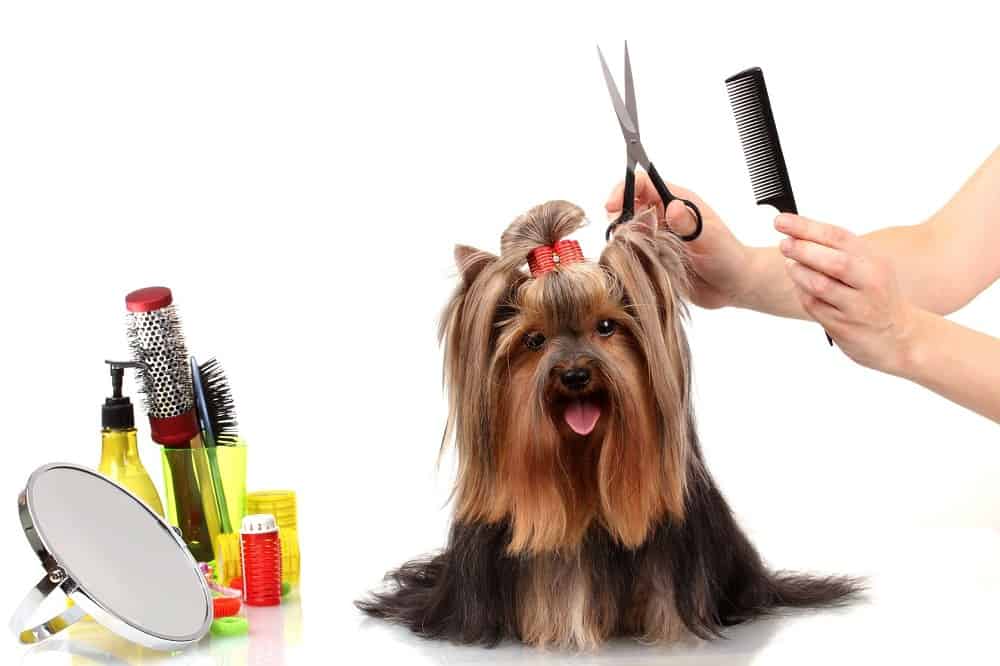The silk coat should feel sleek and silky to handle. The coat appearance, ranges from the very long straight coats of the Afghan Hound and the Irish Setter to the short wavy body coat and long flowing furnishings of the English Cocker Spaniel. Although it is not always apparent, the silk coated dog does have an undercoat. It is very fine and sparse but if you look carefully, you will be able to see it close to the skin.
In the Yorkshire Terrier it is obvious in puppies and on the tips of the ears and often on the feet of older dogs. On the Australian Silky it is obvious on the muzzle and on the lower portion of the legs, below the hock on the hind and the carpal joint on the front.
Generally, the silky hairs are reasonably tough, like our own hair, with the exception of the Afghan Hound and the Saluki, whose coats are reversed. The topcoat is short and very glossy and can be seen on the face and saddle of the Afghan Hound and close to the skin over the rest of the body, and on the face and body of the Saluki Hound.
In both breeds, but more apparently so on the Afghan Hound, the longer length hair is in fact undercoat hair. It is dull, slightly woolly to the touch and extremely fragile, much as a shorter undercoat would be.
Silk coats do not molt in any significant quantity. Generally the hairs grow to a length and then break. If the coat is left long and cared for, it will remain silky but, with the exception of the Afghan Hound, once the coat is clipped down, the undercoat will do its job and often begins to grow longer and denser, giving the silk coat a woolly, dull appearance.
The Skin
The skin on silk coated breeds is generally quite resilient and robust in terms of how it protects the dog. This is in part because the hair covering is generally not particularly dense and itself offers little protection. The skin on some silk coated breeds, though, is fine in texture and can tear and damage easily if subjected to harsh grooming; this is especially the case on the ears and the hocks.
Some wire-toothed brushes are harsh and unforgiving when coming into contact with the skin. The lack of any significant undercoat makes it more likely that these brushes will do damage by scratching or scuffing the skin. Bruising is also a possibility.
If you have to use a wire brush, make sure that it is well worn, so the pad holding the pins is more flexible; alternatively, use a soft touch brush or a pin brush. Use all brushes with minimum pressure.
In some breeds the coat is parted down the center spine, leaving the skin exposed to sunlight; during the summer months this area is vulnerable to sunburn. When this is evident, take particular care not to break the skin or cause further trauma by using your tools with too much vigour.
The technique used when working with de-matting tools can be particularly damaging to the skin on some silk-coated breeds if they are used incorrectly. If the tool is designed to saw (up-and-down action) through the coat then it will exert too much strain on the skin if it is dragged or pulled through the coat, causing bruising and tearing. Check the cutting action of the blade that you are using.
To groom out the silk coat you will need:
- a pin brush (preferably)
- a soft-touch slicker (alternative)
- a de-matting tool (possibly)
- a wide comb and a medium comb.
The pin brush is preferable to a slicker, but a bristle brush, despite its gentle action, is more likely to cause static, resulting in the coat becoming unmanageable and even knotting up in some cases.
Check the coat for mats and tangles. If possible, use your fingers to tease mats apart and then use your brush to work them out; if they are stubborn, you may need to use a de-matter. Work gently from the skin towards the end of the coat length and then brush the knot away.
Start on a hind leg and use your supporting hand to lift the coat upwards towards the body, so you can see the skin underneath the length. Use your brush to go through the coat in layers, working up towards the top of the leg. Continue over the other legs and then brush the body coat with the way it falls, usually straight towards the ground.
Use your wide comb to work through the coat in the same manner and then follow it with your medium comb. (A fine comb is likely to be too severe on these coats and may pull the coat out rather than groom it through.) The coat is now ready for bathing or rough clipping.
Coat Maintenance
This depends on the breed and lifestyle of the dog. A dog in full coat needs regular daily brushing and will need to be bathed at least once every two weeks. If the coat is styled, as is often the case with pet dogs, the coat needs to be groomed at least once a week and will need to be restyled approximately every ten to twelve weeks, with bathing as required.

